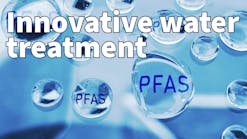About the author: Jill Marie Majka is marketing manager for Chlorinators, Inc. Majka can be reached at 800.327.9761 or by e-mail at [email protected].
Jill Marie Majka
undefined
Just 35 miles northeast of Topeka, Kan., is a small town nestled in the countryside called Oskaloosa. Here you will find an authentic old-time soda fountain at the local pharmacy and boaters and fishermen on Perry Lake enjoying the fresh air and rolling hills. You will also find two down-to-earth guys making sure that the residents are receiving clean, pure drinking water.
Walter Means and Mike George, the two water treatment operators for Rural Water District No. 7 in Jefferson County, are self-professed simple guys, and they want their chlorination system simple as well.
Although some local and state governments have pushed water operators to switch their facilities from gas chlorine to hypochlorites, also known as bleach or tablets, many water treatment facilities, when given the choice, continue using chlorine gas, including the operators at the Oskaloosa facility.
Gas Chlorination
Gas chlorination involves a vacuum regulator affixed to either 150-lb cylinders or, for larger applications, directly mounted to containers weighing about one ton that have an adaptor. The vacuum regulator allows the operator to adjust the chlorine feed rate according to the demands of the water being treated.
Unlike gas chlorine, hypochlorites are more of a hassle to deal with, according to Means. “Bleach was never an option,” he said. “The state of Kansas was trying to push bleach for a while, but then they backed away from it.”
Water quality is also a concern for Means. “Kill time with bleach takes too long,” he said. “Our first customer is four minutes away, so gas chlorine is the only way for us to fly.”
The corrosive nature of bleach is also not appealing to Means. “I’ve seen other operators work with bleach, and it’s not a pretty thing to work with,” he said. “The bleach peels the paint off the walls and eats the metal, and the fumes are always there.”
George, the water facility’s back-up operator, also has his opinion about hypochlorites. “I know other operators who use hypochlorites and it’s time consuming,” he said. “Gas chlorine is easy, and if it is handled safely, there’s no better way to disinfect water as far as I’m concerned.”
Securing Chlorine Cylinders
In recent years, the Department of Homeland Security has urged water and wastewater facilities to tighten up on securing chlorine cylinders.
“We weigh and log our chlorine cylinder every day—we’re extremely consistent,” said Means. “We buy three cylinders at a time and we chain all cylinders to the wall. The unused cylinders are stored behind a triple-plated steel door with a double padlock. We don’t want a 150-lb cylinder getting out to the general population. Gas chlorine is easily handled if you just use a bit of common sense.”
Inventory Matters
The Oskaloosa facility and its chlorine supplier take chlorine inventory seriously. The supplier logs the serial numbers of each cylinder coming in and going out of its facility, according to Means.
“The supplier makes sure the right cylinder number is on it,” Means said. “They inspect every cylinder every time, and we get the paperwork.”
Rural Water District No. 7 uses Chlorinators, Inc.’s Regal gas chlorinator as its means of delivering chlorine into the water supply.
“I’ve been working with Regal products since 1994. It’s simple to operate and almost leak-proof,” said Means. “Regal parts are always available, and we virtually have no trouble. I’ve worked on other gas chlorinators without much luck because the units have way too many parts. We have no downtime or disruption with Regal. We can’t be down because I don’t want to produce unsafe water. I drink the water, and my friends drink it too.”


